Braj B.
Kachru
Professor Braj B.
Kachru is the Director of the Centre for
Advanced Study at the University of Illinois,
Champaign, USA. He is the world's leading scholar
inthe field of world Englishes; he has pioneered,
shaped, and defined the linguistic, socio-cultural
and pedagogical dimensions of cross-cultural
diffusion of English.
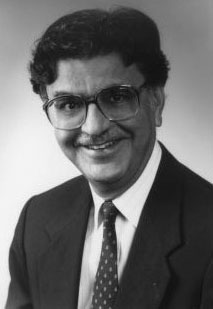
BB Kachru
Professor Kachru is
author or editor of 20 books, including the
prize-winning The Alchemy of English: The
Spread, Functions and Models of Non-Native
Englishes, associate editor of the acclaimed The
Oxford Companion to the English Language and Contributor
to the Cambridge History of the English Language.
In addition, he has written over 100 research
papers, review articles and reviews on Kashmiri
and Hindi languages and literatures, and
theoretical and applied aspects of language in
society. Kachru sits on the editorial boards of
eight scholarly journals, and is founder and
co-editor of the journal World Englishes.
He has chaired many national and international
committees and led several organisations,
including the American Association for Applied
Linguistics. Among his many awards is the Duke of
Edinburgh Award (1987).
Professor Kachru holds
appointments in linguistics, education,
comparative literature and English as an
international language. He is a Jubilee Professor
of Liberal Arts and Sciences and was head of the
Department of Linguistics for 11 years, director
of English as an International Language for six
years, and director of the Linguistic Institute of
the Linguistic Society of America (1978). He has
had fellowships from the British Council, the
East-West Centre and the American Institute of
Indian Studies. He has held visiting
professorships in Canada, Singapore and India.
 A Love for Language A Love for Language
There are books everywhere in his small
office at the UI, spilling from bookshelves onto
worktables, the plush visitor's chair, and the
floor. Even his computer monitor wears a journal,
like a hat. A self-confessed book addict, he reads
and rereads them all.
>>>
|
|
 Naming in the Kashmiri Pandit
Community
Naming in the Kashmiri Pandit
Community
In earlier research on onomastics the concentration has been on two types
of studies: One type focuses on the data on naming processes with
reference to a well-defined social, regional, or religious group. The other type
is essentially comparative, and has implications for defining and illustrating
concepts such as "linguistic area" or "socio-linguistic
area". >>>
|
|
|
|
 Granny
Lalla Granny
Lalla
In
Kashmir, some people consider her a poet, some consider her a
holywoman and some consider her a sufi, a yogi, or a devotee
of Shiva. Sume even consider her an avtar. But every Kashmiri
considers her a wise woman. Every Kashmiri has some sayings of
Lalla on the tip of his tongue. The Kashmiri language is full
of her sayings.
>>>
|
|
 Habba
Khatoon Habba
Khatoon
Habba
at the very outset of her poetic career rebelled against the
prevalent standards of poetry-writing. Textbook idealism is
not found in the dictionary of her pulsating emotions. She did
not also try to bridge the distance between the ideal and the
real. Her substantial contribution in this domain is to
interpret her life as it was and not what it should be.
>>>
|
|
|
|
 Master
Zinda Kaul Master
Zinda Kaul
Masterji
built his personality brick by brick. The foundation
for this was provided. by the Hindu mystic lore
especially by the Kashmir Shaivism. Vedanta and the
Upanishads also acted as the cementing link to make it
more broad-based. Both are portrayed most eloquently
in his 'Sumaran'.
>>>
|
|
 Ghulam
Ahmad Mahjoor Ghulam
Ahmad Mahjoor
Mahjoor
has a place of honor among the poets of Kashmir. He is
especially noted for two things. First, he introduced a new
style into Kashmiri poetry. Second, he introduced a new
thought into Kashmiri poetry. Mahjoor wrote poems of freedom
and progress in Kashmiri. These songs awakened the sleeping
Kashmiris. >>>
|
|
|
|
 Dina
Nath Nadim Dina
Nath Nadim
His
poetry has contributed to Kashmir's struggle for
freedom. Nadim also wrote the first opera in the
Kashmiri language, entitled, bombir ti yembirzal
"The Bumblebee and the Narcissus". Nadim has
greatly influenced the young Kashmiri poets of today.
Kashmiri poetry is still going through the Nadim era.
>>>
|
|
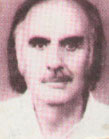 Dina
Nath Nadim (1916-1988) Dina
Nath Nadim (1916-1988)
Epoch-maker
and trend-setter in Kashmiri poetry and prose, Dina Nath Kaul Nadim was
born in March, 1916 and passed away on April 8, 1988. We cherish his memory
and as a token of our respectful homage to this great literatuer and a
lovable human being, we reproduce here this article authored by Prof. Braj
B Kachru, an America based linguist/scholar.
>>>
|
|
|
|
|
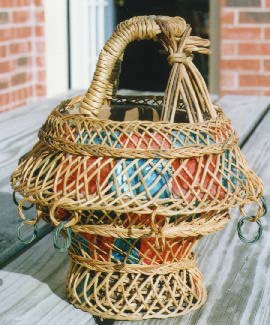 Kaeshir
Ka:ngir Kaeshir
Ka:ngir
In a typical koshur
household, the kangir continues to be the main, inexpensive source of keeping
an individual warm during the winter months. A kangir is made up of two
parts. The outer part is an encasement of wicker. Inside, there is an earthen
bowl-shaped pot called a kondul. The kondul is filled with tsini (charcoal)
and embers. A medium sized kangir holds about a pound of tsini, and its
fire lasts for over six hours. >>>
|
|
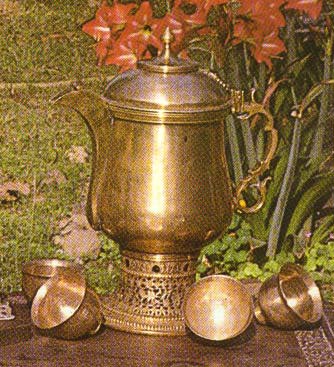 Kashmiri
Sama:va:r Kashmiri
Sama:va:r
There
is no home in Kashmir that does not have a samovar. Each family has one
or two samovars. Kashmiris make tea in the samovar. Kashmiris are very
fond of tea. That is why any time is considered tea time. Inside a samovar
there is a fire-container in which charcoal and live coals are placed.
Around the fire-container there is a space for water to boil. Tea leaves,
sugar, cardamom, and cinnamon are put in the water.
>>>
|
|
|
|
 Mahadev
Bishta: A Clever Thief Mahadev
Bishta: A Clever Thief
It
is indeed a fact that Mahadev was a well-known thief. It is
also true that he would rob people of their property and
wealth. But, in spite of that, people used to sing his
praises. The people loved Mahadev because he would steal from
the wealthy to provide for the needy.
>>>
|
|
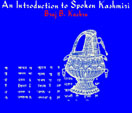 An
Introduction to Spoken Kashmiri An
Introduction to Spoken Kashmiri
External Site.
|
|
